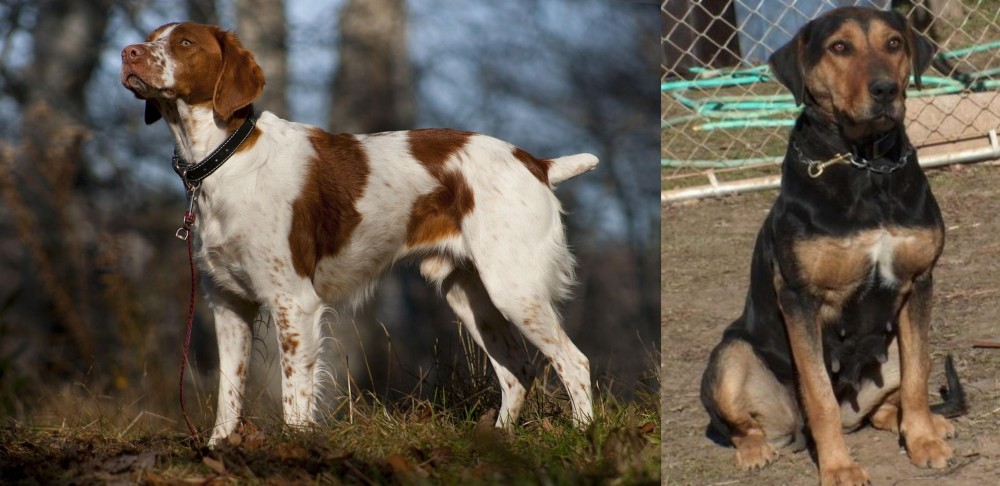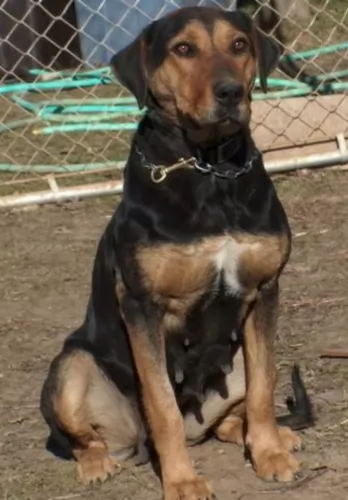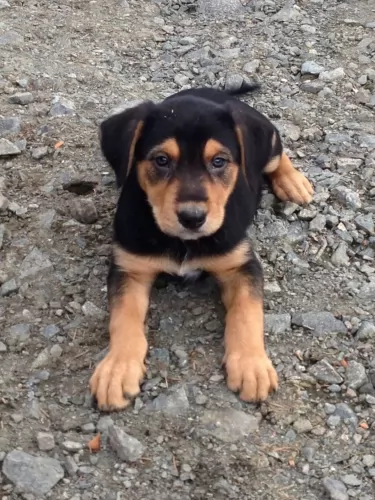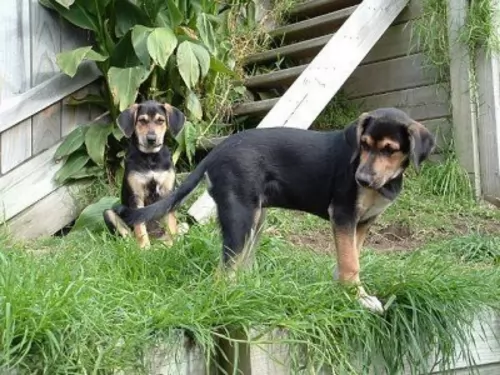 Petzlover
Petzlover Brittany is originated from France but New Zealand Huntaway is originated from New Zealand. Brittany may grow 8 cm / 3 inches shorter than New Zealand Huntaway. Brittany may weigh 20 kg / 44 pounds lesser than New Zealand Huntaway. Both Brittany and New Zealand Huntaway has almost same life span. Brittany may have more litter size than New Zealand Huntaway. Brittany requires Low Maintenance. But New Zealand Huntaway requires Moderate Maintenance
Brittany is originated from France but New Zealand Huntaway is originated from New Zealand. Brittany may grow 8 cm / 3 inches shorter than New Zealand Huntaway. Brittany may weigh 20 kg / 44 pounds lesser than New Zealand Huntaway. Both Brittany and New Zealand Huntaway has almost same life span. Brittany may have more litter size than New Zealand Huntaway. Brittany requires Low Maintenance. But New Zealand Huntaway requires Moderate Maintenance
 One of the most intense bird dog breeds in existence is the Brittany, bred for hunt. The breed used to be called the Brittany Spaniel, but since the breed is closer to a setter or pointer, that moniker has been dropped. The Brittany is named for the French Province in which they were originally developed. Sometime from the 17th to the 19th centuries, the breed was developed. Images of a very similar dog can be found on 17th century paintings and tapestries. However, the first written description comes from 1850 by a Reverend Davies, describing a hunting episode. The breed was recognized officially in the early part of the 20th century and made a splash at the 1900 Paris Dog Show.
One of the most intense bird dog breeds in existence is the Brittany, bred for hunt. The breed used to be called the Brittany Spaniel, but since the breed is closer to a setter or pointer, that moniker has been dropped. The Brittany is named for the French Province in which they were originally developed. Sometime from the 17th to the 19th centuries, the breed was developed. Images of a very similar dog can be found on 17th century paintings and tapestries. However, the first written description comes from 1850 by a Reverend Davies, describing a hunting episode. The breed was recognized officially in the early part of the 20th century and made a splash at the 1900 Paris Dog Show.
The first official standards were written in about 1907 and the breed was recognized by the American Kennel Club (AKC) in 1934.The Brittany is expected to point to and then retrieve birds and other small ground game. Because the Brittany both points and retrieves they are known in the U.K. as a Hunt, Point and Retrieve breed or an HPR, and they have more Dual Champions than the rest of the AKC Sporting group.
There are actually two types of Brittanys in the minds of many breeders. There is the “French” Brittany and the “American” Brittany. When the breed arrived in the United States in 1931 they became immensely popular in a short period of time. In 1942 American Breeders began the American Brittany Club, rewriting the French standard to fit the dog they knew. Today there are definitely difference between the two sub-sets that can easily be seen. The French dog is smaller than the American dog. The American dog is a runner pacing ahead of the hunter while the French dog works more closely with their human companions. Another visible difference is that the French accept black spotted Brittanys, while in the United States a black spotted coat is considered a fault. Both sub-sets are known for their willingness to follow human directions, their eagerness for the hunt, and their agility and speed.
Unfortunately, the European wars took their toll on this breed as they did on many others. Following the second World War, their numbers in Europe were drastically reduced. The French had stop breeding them altogether during the war. It was in this depleted gene pool that the French agreed to accept the black spotted Brittany. Along with the U.S., Canada also does not recognize the black spotted Brittany.
 The New Zealand Huntaway was developed in New Zealand. The dog was brought about by mixing the Border Collie with a number of other breeds, of which the Doberman Pinscher is one.
The New Zealand Huntaway was developed in New Zealand. The dog was brought about by mixing the Border Collie with a number of other breeds, of which the Doberman Pinscher is one.
The idea was to have a skilled herding dog for livestock, and the Huntaway is known for its loud bark which it uses to herd.
The dog is looked upon as as a fairly new breed, dating from the late 19th century. These days it is a popular companion dog, and in 2013 was recognized by the New Zealand Kennel Club.
 The Brittany is much like other hunting dogs – pointers and retrievers – in size and stature. He is solid and strong but not heavy. He is compact with an average size head and floppy ears, docked tails or short natural tails, and expressively intelligent looking eyes. He is athletic, energetic, and alert. He has a long, elastic and free gait. The French dog is smaller and the dog with black spots is accepted. The American Brittany is larger and only a tri-color of orange, liver and white is acceptable.
The Brittany is much like other hunting dogs – pointers and retrievers – in size and stature. He is solid and strong but not heavy. He is compact with an average size head and floppy ears, docked tails or short natural tails, and expressively intelligent looking eyes. He is athletic, energetic, and alert. He has a long, elastic and free gait. The French dog is smaller and the dog with black spots is accepted. The American Brittany is larger and only a tri-color of orange, liver and white is acceptable.
 As a deep chested, medium to large sized dog, the New Zealand Huntaway stands at between 50 and 60cm and weighs roughly 25 to 40kg.
As a deep chested, medium to large sized dog, the New Zealand Huntaway stands at between 50 and 60cm and weighs roughly 25 to 40kg.
The eyes are soft and kind. The coat is usually black and tan colored, although it can be brindle too. The coat is in different textures and can be mostly smooth, but also fairly rough textured. The ears are usually medium length and floppy, the legs straight and long and the tail is long.
These dogs are good natured and are guaranteed to make a splendid family pet. Because they have always been used to life in the country, they are more suited to this lifestyle than for living in the city.
They are friendly, energetic dogs and will require a good deal of exercise.They don’t take easily to lying around bored and this lifestyle will just lead to frustration and destructive behavior, through no fault of their own.
Just like with any other dog, the New Zealand Huntaway will need to be trained and socialized so that he becomes obedient and well rounded. This is necessary for him as he is an independent canine with a determined streak.
His intelligence will mean he is able to learn easily. He also is gentle and kind-hearted, and gets on well with kids and pets in the home.
 The Brittany is particularly trainable and friendly. They love to play and are sweet-natured. They don’t due well with harsh correction though and a stern look will cause them to wither. Socialize them young or they can become shy around strangers. They are loyal and family oriented. They can easily become attached to their humans.
The Brittany is particularly trainable and friendly. They love to play and are sweet-natured. They don’t due well with harsh correction though and a stern look will cause them to wither. Socialize them young or they can become shy around strangers. They are loyal and family oriented. They can easily become attached to their humans.
 The Huntaway has got so much going for him to make him a splendid family pet. Not only is he intelligent, but he is evenly balanced, friendly, social and active.
The Huntaway has got so much going for him to make him a splendid family pet. Not only is he intelligent, but he is evenly balanced, friendly, social and active.
He can easily be trained and socialized. He is friendly and gentle with other pets in the home as well as with children. With a firm, fair, kind, patient and consistent owner in his life, this dog with the gentle brown eyes will be a fantastic pet for you.
 The breed is a hardy one and Brittanys are mostly healthy dogs. In Europe 1 in 5 dogs dies of old age and that age is usually 14 or 15 years. They do have a few issues that they may be susceptible to. These would include:
The breed is a hardy one and Brittanys are mostly healthy dogs. In Europe 1 in 5 dogs dies of old age and that age is usually 14 or 15 years. They do have a few issues that they may be susceptible to. These would include:
 The Huntaway is the kind of dog that won’t require you having to rush off to the vet with him. Good care with nutritious food and exercise can see him reaching 14 years of age or so.
The Huntaway is the kind of dog that won’t require you having to rush off to the vet with him. Good care with nutritious food and exercise can see him reaching 14 years of age or so.
Some common dog illnesses to look out for include -
This disease is about degeneration of the heart muscle with the muscle becoming thinner. The pressure of the blood inside the heart causes these thin walls to stretch, resulting in the heart becoming enlarged.
Although heart disease develops slowly, severe congestive heart failure can develop quickly and you may notice rapid breathing and a blue tongue. It is imperative to get your pet to the vet immediately.
Small studies have revealed that the rate of Dilated Caridomyopathy could be higher in Huntaways.
This is an issue where the hips haven’t formed properly. Affected dogs lose their mobility and battle with pain and lameness. Certainly you will need to get your pet to the vet to make sure that he is pain-free and comfortable.
 Don’t overfeed your Brittany. Keep him at hunting weight by feeding a half a cup up to 2 cups per day depending on the size of your dog and activity levels. Serve this in two meals not one.
Don’t overfeed your Brittany. Keep him at hunting weight by feeding a half a cup up to 2 cups per day depending on the size of your dog and activity levels. Serve this in two meals not one.
Ears – prone to infections – make sure that you check them and wipe them out routinely to prevent infections.
Hip Dysplasia – bones don’t fit well into joints – this can be genetic or otherwise, causing lameness and arthritis. If severe it can require surgery to correct.
Epilepsy – mild or serious seizures are possible. This can be genetic/hereditary but is set off by an infectious disease of the brain, head injury, poison, tumor, or metabolic disorder. There is no cure, but medication can be very effective.
Hypothyroidism – Low levels of thyroid hormone – can cause drooping eyelids, obesity, lethargy, mental difficulties or irregular heat cycles or all of this. Medication is available as it is for humans but must be taken daily for the rest of the dog’s life
Canine Discoid Lupus Erythematosus – autoimmune disease that is rare in dogs. Cats and humans can also have it. It is a skin disease and does not become the more serious and deadly Systemic Lupus. The Discoid version of this disease causes loss of pigmentation and a scaling on the nose which can then progress to the skin around the ears, eyes and genitals. There could be ulcerated lesions and tissue death in more severe cases. Sun exposure can make the condition worse.
The Brittany is a hunting dog that acts like a pointer but will retrieve fowl and birds in the water or on land. If you don’t hunt, the Brittany can still be your family dog. They need lots of exercise and mental stimulation. They need a job if they are not going to hunt and expect them to be distracted by every bird they see. Try flyball, agility, FAST CAT, field trials and dock diving. They are very task oriented and have boundless energy. They excel at obedience and confirmation as well.
 This dog is an average shedder and fairly low maintenance, requiring you to brush him twice a week to keep the coat shiny and free from loose hairs.
This dog is an average shedder and fairly low maintenance, requiring you to brush him twice a week to keep the coat shiny and free from loose hairs.
Dogs that have floppy- or folded ears need to have their ears checked for infection as well as their eyes. They also need to have the nails trimmed as left long, they can hook onto things which can rip into the dog’s flesh.
The Huntaway is a herding dog, and even though your dog today is more of a companion dog, he will need to be fed a high-quality commercial dog food which has been particularly formulated for active working dog breeds.
It is a good idea to sometimes break away from a bowl of kibble and to mix in some homemade food. The simpler the better for your dog, and boiled chicken, some brown rice or pasta and some vegetables such as sweet potato, carrots and spinach mixed into his kibble occasionally will do him the world of good.
Now and then you can also add in some raw meat if possible. Avoid exotic, spicy foods with your pet to avoid digestive problems.
This dog has always been a hunting, herding dog so it is going to require a lot of exercise to keep him content and happy.
He won’t only need physical exercise but will also need mental stimulation as he is an intelligent dog too. Apart from taking him for walks and giving him ball- and rope games, for mental stimulation, why not consider some food puzzle toys?
These are sturdy containers that hold dog food and treats inside. Dogs have to paw at it, lick, shake and think up ways to get at the tasty treat. These food puzzle toys will keep your pet occupied for a while and keep him happily thinking.